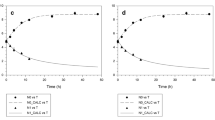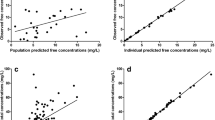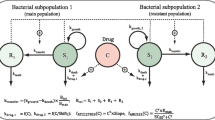Abstract
Purpose
Tigecycline is one of few antibiotics active against multidrug-resistant bacteria; however, the assessment of dosing strategies to optimize its activity is needed. The purpose was to use Monte Carlo Simulation (MCS) to determine if safe tigecycline dosing options attaining breakpoints for pharmacokinetic/pharmacodynamic (PK-PD) targets in non-critically ill adults could be identified.
Methods
Publications that evaluated tigecycline dosing regimens and provided mean PK variables of interest (minimum 2 of: elimination rate constant or half-life and volume of distribution or clearance), with SDs, were included. Weighted mean (±SDs) for each PK parameter were determined. Food and Drug Administration minimum inhibitory concentration (MIC) tigecycline breakpoints for susceptible (MIC ≤ 2 μg/mL), intermediate (MIC 4 μg/mL), and resistant (MIC ≥ 8 μg/mL) Enterobacteriaceae were used. MCS probability distributions for PK-PD target attainment of AUC for total tigecycline plasma concentration from 0 to 24 h following an intravenous dose (AUCtotal, 0-24h) to MIC ratios of ≥ 18, 7, and 4.5 were generated, with success defined as ≥ 80% probability of target attainment at a given MIC.
Results
Ten studies (n = 442) were eligible. Tigecycline 150 mg IV q12h for ward patients with resistant bacteria up to a MIC of 0.48, 1, and 2 μg/mL for an AUCtotal, 0-24h/MIC target attainment of 18, 7, and 4.5, respectively, may be appropriate.
Conclusion
Bacterial infections with tigecycline MICs ≥ 0.48–2 μg/mL, depending on AUCtotal, 0-24h/MIC target, may require treatment with alternate antibiotics due to target attainment failure.







Similar content being viewed by others
Data availability
The data that supports the findings of this study are available in the supplementary material of this article.
References
Boucher HW, Ambrose PG, Chambers HF, Ebright RH, Jezek A, Murray BE, Newland JG, Ostrowsky B, Rex JH (2017) White paper: developing antimicrobial drugs for resistant pathogens, narrow-Spectrum indications, and unmet needs. J Infect Dis 216(2):228–236. https://doi.org/10.13039/100004440
deKraker MEA, Stewardson AJ, Harbarth S (2016) Will 10 million people die a year due to antimicrobial resistance by 2050? PLoS Med 13(11):e1002184. https://doi.org/10.1371/journal.pmed.1002184
Yahav D, Lador A, Paul M, Leibovici L (2011) Efficacy and safety of tigecycline: a systematic review and meta-analysis. J Antimicrob Chemother 66(9):1963–1971. https://doi.org/10.1093/jac/dkr24
Boucher HW, Talbot GH, Bradley JS, Edwards JE, Gilbert D, Rice LB, Scheld M, Spellberg B, Barlett J (2009) Bad bugs, no drugs: no ESKAPE! An update from the Infectious Diseases Society of America. Clin Infect Dis 48(1):1–12. https://doi.org/10.1086/595011
Peterson LR (2009) Bad bugs, no drugs: no ESCAPE revisited. Clin Infect Dis 49(6):992–993. https://doi.org/10.1086/605539
Roberts JA, Kirkpatrick CMJ, Lipman J (2011) Monte Carlo simulations: maximizing antibiotic pharmacokinetic data to optimize clinical practice for critically ill patients. J Antimicrob Chemother 66(2):227–231. https://doi.org/10.1093/jac/dkq449
Wong D, Nielsen TB, Bonomo RA, Pantapalangkoor P, Luna B, Spellberg B (2017) Clinical and pathophysiological overview of Acinetobacter infections: a century of challenges. Clin Microbiol Rev 30(1):409–447. https://doi.org/10.1128/CMR.00058-16
Coelho JM, Turton JF, Kaufmann ME, Glover J, Woodford N, Warner M, Palepou MF, Pike R, Pitt TL, Patel BC, Livermore DM (2006) Occurrence of Carbapenem-resistant Acinetobacter baumannii clones at multiple hospitals in London and Southeast England. J Clin Microbiol 44(10):3623–3627. https://doi.org/10.1128/JCM.00699-06
Xie J, Wang T, Sun J, Chen S, Cai J, Zhang W, Dong H, Hu S, Zhang D, Wang X, Dong Y (2014) Optimal tigecycline dosage regimen is urgently needed: results from a pharmacokinetic/pharmacodynamic analysis of tigecycline by Monte Carlo simulation. Int J Infect Dis 18:62–67. https://doi.org/10.1016/j.ijid.2013.09.008
Xie J, Roberts JA, Abdulaziz AS, Roger C, Wang Y, Yang Q (2017) Population pharmacokinetics of Tigecycline in critically ill patients with severe infections. Antimicrob Agents Chemother 61(8):e000345–e000317. https://doi.org/10.1128/AAC.00345-17
Meagher AK, Passarell JA, Cirincione BB, Van Wart SA, Liolios K, Babinchak T, Ellis-Grosse EJ, Ambrose PG (2007) Exposure-response analysis of Tigecycline efficacy in patients with complicated skin and skin-structure infections. Antimicrob Agents Chemother 51(6):1939–1945. https://doi.org/10.1128/AAC.01084-06
FDA (2010) Drug Safety Communication: Increased risk of death with Tygacil (tigecycline) compared to other antibiotics used to treat similar infections https://www.fda.gov/drugs/drug-safety-and-availability/fda-drug-safety-communication-increased-risk-death-tygacil-tigecycline-compared-other-antibiotics (Accessed 12 July 2020)
Freire AT, Melnyk V, Kim MJ, Datsenko O, Dzybulik O, Glumcher F, Chuang YC, Maroko RT, Dukart G, Cooper CA, Koth-Bradley JM, Dartois N, Gandjini H (2010) Comparison of tigecycline with imipenem/cilastatin for the treatment of hospital-acquired pneumonia. Diagn Microbiol Infect Dis 68:140–151. https://doi.org/10.1016/j.diagmicrobio.2010.05.012
Reed GA, Schiller GJ, Kambhampati S, Tallman MS, Douer D, Minden MD, Yee KW, Gupta V, Brandwein J, Jitkova Y, Gronda M, Hurren R, Shamas-Din A, Schuh A, Schimmer AD (2016) A phase 1 study of intravenous infusions of tigecycline in patients with acute myeloid leukemia. Cancer Med 5(11):3031–3040. https://doi.org/10.1002/cam4.845
Muralidharan G, Micalizzi M, Speth J, Raible D, Troy S (2005) Pharmacokinetics of Tigecycline after single and multiple doses in healthy subjects. Antimicrob Agents Chemother 49(1):220–229 10.1128/AAC.49.1.220–229.2005
Yamashita N, Matschke K, Gandhi A, Korth-Bradley J (2014) Tigecycline pharmacokinetics, tolerability, safety, and effect of intestinal microflora in healthy Japanese male subjects. J Clin Pharmacol 54(5):513–519. https://doi.org/10.1002/jcph.236
Marchaim D, Pogue JM, Tzuman O, Hayakawa K, Lephart PR, Salimnia H, Painter T, Zervos MJ, Johnson LE, Perri MB, Hartman P, Thyagarajan RV, Major S, Goodell M, Fakih MG, Washer LL, Newton DW, Malani AN, Wholehan JM, Mody L, Kaye KS (2014) Major variation in MICs of Tigecycline in gram-negative bacilli as a function of testing method. J Clin Microbiol 52(5):1617–1621. https://doi.org/10.1128/JCM.00001-14
Antibacterial agents in clinical development: an analysis of the antibacterial clinical development pipeline, including tuberculosis. Geneva: World Health Organization; 2017 (WHO/EMP/IAU/2017.12). Licence: CC BY-NC-SA 3.0 IGO. https://apps.who.int/iris/bitstream/handle/10665/258965/WHO-EMP-IAU-2017.11-eng.pdf;jsessionid=B3F49A159A89A6210C1DDD3F38C9C0C8?sequence=1. Accessed 12 July 2020
Hoffmann M, DeMaio W, Jordan RA, Talaat R, Harper D, Speth J, Scatina J (2007) Metabolism, excretion, and pharmacokinetics of [14C] Tigecycline, a first-in-class Glycylcycline antibiotic, after intravenous infusion to healthy male subjects. Drug Metab Dispos 35(9):1543–1553. https://doi.org/10.1124/dmd.107.015735
Korth-Bradley JM, McGovern PC, Salageanu J, Matschke K, Plotka A, Pawlak S (2013) Tigecycline does not prolong corrected QT intervals in healthy subjects. Antimicrob Agents Chemother 57(4):1895–1901. https://doi.org/10.1128/AAC.01576-12
Korth-Bradley JM, Troy SM, Matschke K, Muralidharan G, Fruncillo RJ, Speth JL, Raible DG (2012) Tigecycline pharmacokinetics in subjects with various degrees of renal function. J Clin Phamacol 52(9):1379–1387. https://doi.org/10.1177/0091270011416938
Korth-Bradley JM, Baird-Bellaire SJ, Patat AA, Troy SM, Bohmer GM, Gleiter CG, Buecheler R, Morgan MY (2011) Pharmacokinetics and safety of a single intravenous dose of the antibiotic tigecycline in patients with cirrhosis. J Clin Pharm Ther 51(1):93–101. https://doi.org/10.1177/0091270010363477
Nord CE, Sillerstrom E, Wahlund E (2006) Effect of tigecycline on normal oropharyngeal and intestinal microflora. Antimicrob Agents Chemother 50(10):3375–3380. https://doi.org/10.1128/AAC.00373-06
Muralidharan G, Fruncillo RJ, Micalizzi M, Raible DG, Troy SM (2005) Effects of age and sex on single-dose pharmacokinetics of tigecycline in healthy subjects. Antimicrob Agents Chemother 49(4):1656–1659 10.1128/AAC.49.4.1656–1659.2005
Conte JE, Golden JA, Kelly MG, Zurlinden E (2005) Steady-state serum and intrapulmonary pharmacokinetics and pharmacodynamics of tigecycline. Int J Antimicrob Agents 25(6):523–529. https://doi.org/10.1016/j.ijantimicag.2005.02.013
Bulik CC, Wiskirchen DE, Shepard A, Sutherland CA, Kuti JL, Nicolau DP (2010) Tissue penetration and pharmacokinetics of tigecycline in diabetic patients with chronic wound infections described by using in vivo microdialysis. Antimicrob Agents Chemother 54(12):5209–5213. https://doi.org/10.1128/AAC.01051-10
Clinical and Laboratory Standards Institute (2017) Performance standards for antimicrobial susceptibility testing. 27th informational supplement. Approved standard M100-S27. Clinical and Laboratory Standards Institute, Wayne, PA. https://www.google.com/search?q=2017+CLSI+27th+information+supplement+antimicrobial+susceptibility+standards&rlz=1C1GGRV_enCA804CA805&oq=2017+CLSI+27th+information+supplement+antimicrobial+susceptibility+standards&aqs=chrome..69i57.23871j0j9&sourceid=chrome&ie=UTF-8. Accessed 12 July 2020
Pfizer Canada. Tygacil (tigecycline) package insert (2020) Kirkland, Quebec. https://www.pfizer.ca/sites/default/files/202005/TYGACIL_PM_E_235179_21Apr2020.pdf (Accessed 12 July 2020)
Ni W, Liang B, Cai Y, Liu Y, Bai N, Ciu J, Wang R (2014) A pharmacodynamic simulation to evaluate tigecycline in treatment of nosocomial pneumonia caused by multi-drug resistant Acinetobacter baumannii. Pak J Pharm Sci 27(3):463–467 No doi identified
Nicolau DP, Quintana A, Korth-Bradley JM, Wible M, Dowzicky MJ (2015) Rationale for maintaining current Tigecycline breakpoints as established by the USA Food and Drug Administration. Arch Clin Microbiol 6(4):7 No doi identified
Eagye KJ, Kuti JL, Dowzicky M, Nicolau DP (2007) Empiric therapy for secondary peritonitis: a pharmacodynamic analysis of cefipime, ceftazidime, ceftriaxone, imipenem, levofloxacin, piperacillin/tazobactam, and tigecycline using Monte Carlo simulation. Clin Ther 29(5):889–899. https://doi.org/10.1016/j.clinthera.2007.05.018
Wei C, Ni W, Cai X, Cui J (2015) A Monte Carlo pharmacokinetic/pharmacodynamic simulation to evaluate the efficacy of minocycline, tigecycline, moxifloxacin, and levofloxacin in the treatment of hospital acquired pneumonia caused by Stenotrophomonas maltophilia. Infect Dis 47(12):846–851. https://doi.org/10.3109/23744235.2015.1064542
Rubino CM, Ma L, Bhavnani SM, Korth-Bradley J, Speth J, Ellis-Grosse E, Rodvold KR, Ambrose PG, Drusano GL (2007) Evaluation of tigecycline penetration into colon wall tissue and epithelial lining fluid using a population pharmacokinetic model and Monte Carlo simulation. Antimicrob Agents Chemother 51(11):4085–4089. https://doi.org/10.1128/AAC.00065-07
Ni W, Li G, Zhao L, Cui J, Wang R, Gao Z, Liu Y (2018) Use of Monte Carlo simulation to evaluate the efficacy of tigecycline and minocycline for the treatment of pneumonia due to carbapenemase-producing Klebsiella pneumoniae. Infect Dis 50(7):507–513. https://doi.org/10.1080/23744235.2018.1423703
Xu Y, Jin L, Liu N, Luo X, Dong D, Tang J, Wang Y, You Y, Liu Y, Chen M, Yu Z, Hao Y, Gu Q, (2019) Evaluation of the ratio of the estimated area under the concentration-time curve to minimum inhibitory concentration (estimated AUIC) as a predictor of the outcome for tigecycline treatment for pneumonia due to multidrug-resistant bacteria in an intensive care unit. Int J Infect Dis 82:79–85. https://doi.org/10.1016/j.ijid.2019.03.011
Funding
This research did not receive any specific grant from funding agencies in the public, commercial, or not-for-profit sectors.
Author information
Authors and Affiliations
Contributions
Brianna Kispal: data collection, data analysis, manuscript development; Sandra Walker: project supervisor, study conceptualization, methods development, data analysis, manuscript development.
Corresponding author
Ethics declarations
Conflict of interest
All authors attest that they have no competing interests to declare.
Code availability
Not applicable.
Ethics approval
Not required.
Consent to participate
Not applicable.
Consent for publication
Not applicable
Additional information
Publisher’s note
Springer Nature remains neutral with regard to jurisdictional claims in published maps and institutional affiliations.
Electronic Supplementary Material
ESM 1
(PDF 90.6 kb)
Rights and permissions
About this article
Cite this article
Kispal, B., Walker, S.A.N. Monte Carlo simulation evaluation of tigecycline dosing for bacteria with raised minimum inhibitory concentrations in non-critically ill adults. Eur J Clin Pharmacol 77, 197–205 (2021). https://doi.org/10.1007/s00228-020-02998-7
Received:
Accepted:
Published:
Issue Date:
DOI: https://doi.org/10.1007/s00228-020-02998-7




